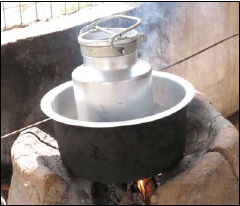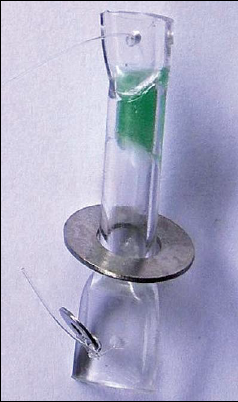As most of the informal milk market customers are looking for fresh milk, the best preservation methods include boiling, pasteurising and cooling. If there is a well paying market for fermented milk products like yoghurt or mala/suza, this can be undertaken as a special value addition for income generation project.
Boiling or pasteurising of milk
Boiling of milk will kill all disease causing germs. However the toxins produced especially mastitis by causing germs will not disappear. Mastitis milk will have to be identified at producer level.
Early last century a method of killing disease germs in milk was invented. It is called pasteurisation. Many people believe – quite rightly – that boiling of milk reduces the nutritional value of same milk. Especially the vitamin C content is reduced by boiling.
Pasteurisation in a closed milk can has several benefits over boiling milk over an open fire while stirring:
- No or very little milk loss due to evaporation (make sure the lid is closed)
- No skin on the milk (again make sure the lid is closed) Very little loss of vitamins
- No burnt taste
- No boiled taste
Pasteurisation process:
Heating milk in a water bath to 65°C for 20 minutes, or heating to 72ºC for 15 seconds then cooling quickly by transferring the milk cans to cold water bath.
This process will kill all known disease causing germs. The cooling is also important for milk, as there can be some heat resistant spoilage bacteria that can cause the milk to curdle at high temperatures (sweet curdling). Anyone used to leaving hot milk in a thermos flask will have seen this sweet curdling.

To determine when the milk hasreached the above temperatures we can simply measure with a food thermometer, but these are not easily available and besides are made of glass so they break easily.
NAREWAMA (FaustineOdaba“MamaSolar”–Facebook) haveintroduced a small gadget called a “WAPI”. This is a small clear nylon tube containing a bit of green (melting at 65°C) or white (melting at 75ºC) wax and sealed in both ends.
The “WAPI” – is attached to a string and some small steel washers to keep it balanced. After use it can simply be inverted for the melted wax to again be on top for the next pasteurisation.
Immersing this wapi into the milk and checking from time to time will clearly show when the milk is hot enough – the wax has melted and sunk to the other end of the WAPI, and the milk can be cooled. Such a gadget can be bought at KSh 150/- and will last a long time provided it is not given to children to play with. It is also easy to clean and sterilise with a bit of boiling water. Using aWAPI or a thermometer can save firewood.

Cooling of milk
Milk keeps very well under cold temperatures. However temperatures in ASAl are never cold, so temperature is a major factor affecting milk spoilage.
Some measures can be employed to lower the temperatures where you store the milk:
- Build shaded shelters to screen out the major part of the solar heat for milk storage while waiting for transport. A shaded area is many degrees lower than the full sunshine of the environment, especially if there is a bit of wind passing through. Storing milk in a shaded area will make it keep longer
- Try evaporation coolers.This technology has been around fora long time. The principle behind it is that water uses heat to evaporate. This heat can be taken from a small chamber storing milk and other products if properly constructed. Evaporation coolers can lower temperatures up to 10°C compared to the surrounding environment. Several designs have been tested in various parts of the world depending on available materials.